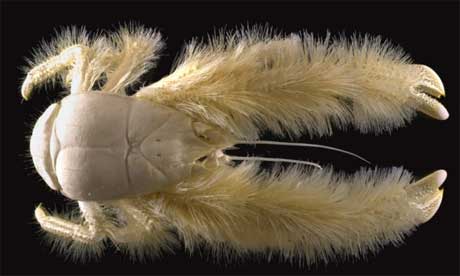Even in the world's harshest environments there are creatures that cling to life equipped with extraordinary survival capabilities. By James Randerson

A newly discovered eyeless crustacean, called a yeti crab or Kiwa hirsuta, which thrives around the hydrothermal vents of the Pacific Antarctic Ridge. Photograph: AP Photo/A. Fifis
Lake Vostok in Antarctica is one of the most inhospitable places on the planet. The Russian research station that sits on top of the ice has clocked up the coldest temperature ever recorded on Earth - an unbelievably chilly minus 89.9C. Beneath the station is ice thousands of metres thick.
But even here, there are organisms that can survive and even thrive. They are not large and flashy, and unlikely to be the stars of nature documentaries. But they are marvels of evolution. By drilling down to 3,600 metres - around 120 metres above the boundary between ice and liquid water - scientists have discovered a menagerie of bacterial species that thrive in the cold.
Welcome to the bizarre and uncomfortable (for us) world of the extremophiles - hardy organisms that thrive under the most punishing conditions. Bacteria and other simple single-celled organisms called archaea are the kings of the severe. Apart from cold-loving species there are organisms adapted to extreme heat, dryness, saltiness and even high radioactivity.
Perhaps the most well-known are the hyperthermophiles that can exist in hot springs and around hydrothermal vents at the bottom of the sea - so called black smokers. These are particularly remarkable because they form the basis of an ecosystem that runs entirely without the sun. Living at depths in the ocean where no rays can penetrate, and where photosynthesis is thereby impossible, these organisms have evolved metabolisms that can run on chemicals in rocks and in the water.
The most impressive hyperthermophile is the recently discovered Strain 121. It is able to keep dividing even at water temperatures of 121C (hence its name). At this depth, due to the extreme pressure, water does not boil.
People have long used salt to preserve food and stop it from being spoiled by microbes - high salt concentration draws water out of, and thus damages, the cells of most living things. However, halophiles or salt-lovers, have adapted to thrive in salt concentrations 10 times those in sea water, or even higher - for example in Utah's Great Salt Lake. The hardiest can survive within salt crystals.
They do so in a variety of different ways, which typically involve raising the concentration of other substances within cells (such as sugars, alcohols and amino acids) which counteract the tendency for water to flood out.
With so many super-hardy creatures on our doorstep here on Earth, the possibility that simple life-forms exist somewhere in the solar system or beyond looks much more likely. Nasa's Galileo spacecraft has discovered environments on Jupiter's frozen moon Europa that are not unlike those at Lake Vostok, and the cold, dry surface of Mars would be home from home for some of the microbes that inhabit Antarctica's Dry Valleys.
That throws up a tricky problem for engineers sending space craft to explore these alien worlds. What if the craft were to carry its own cargo of Earth microbes which set up home there?
One major problem for any accidental interplanetary microbe would be how to survive the punishing radiation bombardment in space. Most would be rapidly frazzled en route. Most, but not all.
Deinococcus radiodurans, nicknamed "Conan the Bacterium", is listed by the Guinness Book of World Records as the "world's toughest bacterium". By rapidly replacing its DNA, it can survive cold, dehydration, vacuum, acid and a hefty radiation dose. Its Latin name means "terrifying berry that withstands radiation".
No comments:
Post a Comment